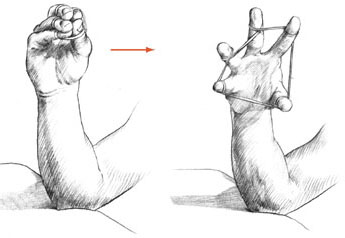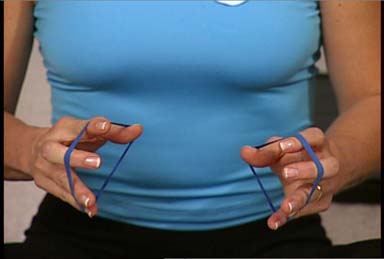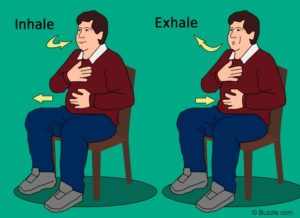Exercise (mini rest-breaks)
To maximize the potential for prevention and recovery, it is important to make a commitment to daily stretching and cardiovascular exercise and to perform strengthening exercises 3-4 times per week depending upon your schedule and your symptoms.
Begin with postural and core strengthening, especially If you are painful or if the injury is acute. Progress into strengthening for the hand, wrist and elbow as symptoms and pain tolerance allows.
Exercise sessions do not need to be long. Taking 2-3 minutes for stretching every hour while working will improve your comfort. Studies show that these mini rest-breaks actually increase your productivity by the end of the day!
Computer stretches
It is important to stretch frequently throughout the day. Every 30-60 minutes or so, take 30 seconds to stretch out of the position you have been in. For example, if seated at a computer, stand up, stretch your back, pull your shoulder blades together, open your arms, turn your palms up, straighten your elbows, look up at the ceiling. Then choose 2 or 3 of the following. Alternate these throughout the day, so that by the end of the day, you will have performed 2-3 repetitions of all.
- Stretches should feel good, not painful.
- Occasionally you may feel a “good pain”. This is okay.
- Perform stretches smoothly and slowly.
- Hold the stretch gently. Do not bounce.
- Breathe slowly, deeply and naturally.
- supination
- triceps- overhead
- triceps – across shoulder
- biceps – behind back
- shoulder circles – emphasize scap retraction, depression
- hands behind head
- neck side-bend- neutral, up, down
- neck rotation- neutral, up, down
- neck retraction- neutral, flexion
Wrist strengthening
- flexion – (wrist curl)
- Place the back of your forearm on a padded chair arm with the palm facing up.
- Keep your shoulders relaxed. Your elbow, shoulder and ear should all line up.
- Holding a comfortable amount of weight (a juice can, soup can, water bottle, small weight, 1-5 pounds depending up your conditioning and symptoms) bend the wrist forward for a count of 4, pause briefly, then release for a count of 4.
- Do not snap the wrist forward.
- Control the release.
- If you have an injury, do not start the movement from an extreme position of wrist extension and do not let the weight roll out to the tips of the fingers.
- extension – (reverse wrist curl)
- place your forearm on a padded arm chair with the palm facing down.
- Keep your shoulders relaxed. Your elbow, shoulder and ear should all line up.
- Holding a comfortable amount of weight (a juice can, soup can, water bottle, small weight, 1-5 pounds depending up your conditioning and symptoms). pull the wrist back for a count of 4, pause briefly, then release for a count of 4.
- Do not snap the wrist back.
- Control the release.
- If you have an injury, do not start the movement from an extreme position of wrist bend.
- radial deviation (hammer curl)
- place the small finger edge of the forearm on a padded chair arm with the thumb side of the hand up.
- Keep your shoulders relaxed. Your elbow, shoulder and ear should all line up.
- Holding a comfortable amount of weight (a juice can, soup can, water bottle, small weight, 1-5 pounds depending up your conditioning and symptoms) gently bend the wrist up towards the thumb then down towards the small finger as if you are slowly using a hammer.
- Do not snap the wrist.
- Control the release.
- supination & pronation – (forearm rotation)
- tuck your elbow gently in at your side.
- Keep your shoulders relaxed. Your elbow, shoulder and ear should all line up.
- Holding a comfortable amount of weight (a juice can, soup can, water bottle, small weight, 1-5 pounds depending up your conditioning and symptoms) slowly rotate your palm up for a count of 4, then rotate your palm down for a count of four.
- All the movement should come from the forearm. Do not let the elbow move in towards the body or out away from the body.
Hand Strengthening
A Word About Grippers, Squeezers & Tennis Balls
Use grippers cautiously. I have found that weakness in repetitive strain injuries is caused by pain, not by lack of use. In fact, the majority of activity that we perform during the day (lifting, gripping, pinching, holding) work the flexors, the muscles that bend the fingers. Squeezing tennis balls or stress balls or using commercial hand strengtheners may only fatigue and stress already over-worked muscles. It is more important, especially when an injury is painful or acute, to create muscle balance by working the extensors, the muscles that open the hand.
- rubber band ext – Rubber bands found in the produce section (binding asparagus stalks or broccoli) work well for this exercise
- putty exercises – putty is available on-line, through some pharmacies or medical supply stores or in sports stores. Make sure that you purchase a soft, medium soft putty, or medium putty. Often, the sports stores carry firmer putty designed for the athlete. This putty is too hard for the exercises described below or for those with hand injuries.
- squeeze
- intrinsics
- roll
- finger extension
- pinch
Upper- Body Strengthening
Frequently in our clinic we work on strengthening activity. Occasionally, when grip strength does not improve with hand strengthening exercises alone, we will see a gain in strength when we add general upper body strengthening activity. With repetitive strain injuries, it is common that the “mirror” muscles (the ones you see when looking in a mirror, such as the pectorals) become tight, and the non-mirror (or back) muscles become weak. The strengthening exercises below target the non-mirror muscles, helping to re-create postural balance.
These are a few samples of the many different techniques used for strengthening these muscles.
- Hold weights lightly (do not squeeze).
- If holding a weight aggravates symptoms, try using an ankle or cuff weight placed on the lower end of the forearm.
- rows
- abduction
- extension
- lat pulls
- external rotation
Core Strengthening
All movement begins from our core: the abdominals, back, trunk and hip muscles. These core muscles stabilize our body. When the core is strong, the power, efficiency and endurance of all muscles are improved.
Improving core strength reduces risk of injuries:
- Improves body stability and flexibility
- Allows the body to move properly
- Supports the movement of our arms
- Increases the efficiency and power of all muscle groups
Diaphragmatic Breathing
Most people tend to breathe using the muscles of the neck and shoulders rather than the diaphragm. Work activity, sedentary activity, and stress increase this tendency. With time, this type of shallow breathing can affect blood flow and nerve and muscle function. Diaphragmatic breathing relaxes the muscles of the neck and shoulders.
Practicing diaphragmatic breathing daily will improve the strength of the diaphragm and improve the quality of out breathing.
- Improves oxygen flow to the body’s tissues
- Reduces stress
- Relaxes the muscles of the neck and shoulders
- Lowers blood pressure and heart rate
- Retrains the body to breathe correctly
- Place a hand on your upper abdomen.
- Inhale deeply through the nose. Your will feel your hand rise as the diaphragm expands.
- Exhale slowly through the lips and gently push in with the hand that is on the diaphragm.
- While exhaling, relax your neck, shoulders and chest.
- Repeat slowly for 5 minutes.
Related Video:


